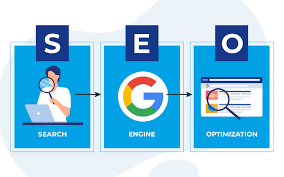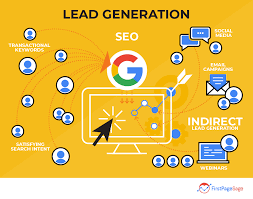The Power of Search Engine Marketing
Search Engine Marketing (SEM) has revolutionised the way businesses promote their products and services online. In today’s digital age, where competition is fierce and attention spans are short, having a strong SEM strategy is essential for staying ahead.
What is SEM?
SEM involves promoting websites by increasing their visibility in search engine results pages through paid advertising. It encompasses a range of tactics, including pay-per-click (PPC) advertising, search engine optimisation (SEO), and other techniques to drive traffic to websites.
The Benefits of SEM
One of the key advantages of SEM is its ability to deliver targeted traffic to websites. By bidding on specific keywords related to your business, you can reach potential customers who are actively searching for products or services like yours. This targeted approach increases the likelihood of converting leads into sales.
SEM also offers measurable results, allowing businesses to track the performance of their campaigns in real-time. With tools like Google Analytics, you can monitor key metrics such as click-through rates, conversion rates, and return on investment (ROI), enabling you to make data-driven decisions to optimise your campaigns.
Best Practices for SEM
To maximise the effectiveness of your SEM campaigns, it’s important to conduct thorough keyword research to identify high-performing keywords that align with your business objectives. Crafting compelling ad copy that entices users to click on your ads is also crucial for driving traffic and generating leads.
Regularly monitoring and adjusting your campaigns based on performance data is essential for improving ROI and achieving long-term success with SEM. A/B testing different ad variations, landing pages, and targeting options can help you fine-tune your strategy for optimal results.
The Future of SEM
As search engines continue to evolve and consumer behaviour shifts towards online channels, the role of SEM in digital marketing will only grow in importance. By staying abreast of industry trends and leveraging new technologies such as machine learning and artificial intelligence, businesses can stay competitive in an increasingly crowded online marketplace.
In conclusion, Search Engine Marketing offers businesses a powerful tool for reaching their target audience, driving traffic to their websites, and achieving measurable results. By implementing best practices and staying informed about industry developments, businesses can harness the full potential of SEM to grow their online presence and drive business success.
Essential Guide to Search Engine Marketing: Understanding SEO vs SEM, Strategies, Examples, and How It Works
- What is difference between SEO and SEM?
- What is an example of SEM?
- What is search engine marketing examples?
- What are the different types of search engine marketing?
- What is search engine marketing Google ads?
- What is an example of search marketing?
- What is an example for search engine marketing?
- What is search engine marketing and how it works?
- What is meant by search engine marketing?
- What is search engine marketing and its types?
- What is an example of search engine marketing?
- What are the steps for search engine marketing?
- What is search engine marketing and how does it work?
- What is SEM vs SEO?
- Why is search engine marketing used?
- What is SEM and how it works?
- What is an example of a search engine marketing?
What is difference between SEO and SEM?
When it comes to Search Engine Marketing (SEM) and Search Engine Optimisation (SEO), a common question that arises is the difference between the two. SEO focuses on improving a website’s organic visibility in search engine results through tactics like keyword optimisation, content creation, and link building. On the other hand, SEM encompasses paid advertising strategies to increase a website’s visibility in search engine results pages. While SEO is a long-term strategy that aims to boost organic traffic, SEM provides immediate visibility through paid ads. Both SEO and SEM play crucial roles in enhancing a website’s online presence, with each serving distinct purposes in the realm of digital marketing.
What is an example of SEM?
An example of Search Engine Marketing (SEM) is running a Google Ads campaign to promote a new line of skincare products. In this scenario, the business bids on relevant keywords such as “anti-ageing creams” and “moisturising serums” to appear at the top of search engine results pages when users search for these terms. By creating compelling ad copy and targeting specific demographics, the business can drive targeted traffic to its website and potentially convert leads into customers. This example illustrates how SEM can be utilised to increase brand visibility, attract potential customers, and generate sales in a competitive online landscape.
What is search engine marketing examples?
When it comes to search engine marketing examples, a common illustration is pay-per-click (PPC) advertising on search engines like Google or Bing. In PPC campaigns, businesses bid on keywords relevant to their products or services, and their ads appear at the top of search results when users enter those keywords. Another example is search engine optimisation (SEO), where businesses optimise their website content to rank higher in organic search results. Both PPC and SEO are effective SEM strategies that can drive targeted traffic to websites and increase visibility in search engine results pages.
What are the different types of search engine marketing?
When it comes to Search Engine Marketing (SEM), there are several different types that businesses can utilise to enhance their online visibility and attract potential customers. The main types of SEM include Pay-Per-Click (PPC) advertising, which involves bidding on keywords to display ads in search engine results; Search Engine Optimisation (SEO), which focuses on improving organic search rankings through optimising website content and structure; and Local Search Marketing, which targets local customers searching for products or services in a specific geographic area. Each type of SEM offers unique benefits and can be tailored to suit the specific goals and target audience of a business.
What is search engine marketing Google ads?
Search engine marketing Google Ads, commonly known as Google Ads or Google AdWords, is a powerful online advertising platform offered by Google. It allows businesses to create ads that appear on Google’s search engine results pages and across its vast network of partner websites. With Google Ads, advertisers bid on keywords relevant to their target audience, and their ads are displayed to users who search for those keywords. This pay-per-click (PPC) advertising model enables businesses to reach potential customers at the precise moment they are searching for products or services, making it a highly effective tool for driving targeted traffic and generating leads.
What is an example of search marketing?
An example of search marketing is pay-per-click (PPC) advertising, where businesses bid on specific keywords related to their products or services to display ads in search engine results. When users search for those keywords, the ads appear at the top or bottom of the search results page. The business only pays when a user clicks on the ad, making it a cost-effective way to drive targeted traffic to their website and increase visibility among potential customers actively searching for relevant information. PPC campaigns allow businesses to set budgets, target specific audiences, and track performance metrics to measure the effectiveness of their advertising efforts.
What is an example for search engine marketing?
An example of search engine marketing (SEM) is a company bidding on specific keywords related to their products or services to have their ads displayed prominently in search engine results pages. For instance, a local bakery might bid on keywords like “fresh pastries” or “artisan bread” to ensure that their website appears at the top of search results when users are looking for these items online. By investing in SEM, businesses can increase their visibility, attract targeted traffic, and ultimately drive conversions and sales through strategic online advertising efforts.
What is search engine marketing and how it works?
Search engine marketing (SEM) is a digital marketing strategy that involves promoting websites by increasing their visibility in search engine results pages through paid advertising. SEM works by allowing businesses to bid on specific keywords related to their products or services, with the aim of appearing at the top of search engine results when users search for those keywords. By targeting relevant keywords and crafting compelling ad copy, businesses can drive targeted traffic to their websites and attract potential customers who are actively searching for what they offer. SEM also includes tactics such as pay-per-click (PPC) advertising and search engine optimisation (SEO) to enhance online visibility and generate leads.
What is meant by search engine marketing?
Search engine marketing, often abbreviated as SEM, refers to a digital marketing strategy aimed at increasing a website’s visibility in search engine results pages through paid advertising. It involves various tactics such as pay-per-click (PPC) advertising and search engine optimisation (SEO) to drive targeted traffic to websites. By strategically bidding on relevant keywords and crafting compelling ad copy, businesses can connect with potential customers who are actively searching for products or services online. SEM provides a measurable and results-driven approach, allowing businesses to track key metrics like click-through rates and conversion rates to optimise their campaigns for maximum impact.
What is search engine marketing and its types?
Search engine marketing (SEM) is a digital marketing strategy that involves promoting websites by increasing their visibility in search engine results pages through paid advertising. SEM encompasses various types of tactics, with the two primary methods being pay-per-click (PPC) advertising and search engine optimisation (SEO). PPC advertising allows businesses to bid on specific keywords and pay for their ads to appear at the top of search results, while SEO focuses on improving a website’s organic ranking through content optimisation and other techniques. Both PPC and SEO are essential components of a successful SEM strategy, offering businesses different ways to drive targeted traffic to their websites and increase online visibility.
What is an example of search engine marketing?
An example of search engine marketing (SEM) can be seen in the sponsored ads that appear at the top of search engine results pages when users enter specific keywords. For instance, when a user searches for “best running shoes,” they may see paid advertisements from athletic shoe brands promoting their products. These ads are strategically placed to attract the attention of users actively seeking information on running shoes, demonstrating how businesses leverage SEM to target relevant audiences and drive traffic to their websites through paid search advertising.
What are the steps for search engine marketing?
When it comes to Search Engine Marketing (SEM), understanding the steps involved is crucial for a successful campaign. The process typically begins with thorough keyword research to identify relevant and high-performing keywords. Once the keywords are identified, the next step involves creating compelling ad copy that resonates with the target audience. Setting up targeted PPC campaigns on search engines like Google is another key step, followed by monitoring and analysing campaign performance to make data-driven adjustments for optimal results. Regularly refining and testing different elements of the campaign, such as ad creatives and landing pages, is essential to continuously improve SEM effectiveness and drive meaningful outcomes for businesses.
What is search engine marketing and how does it work?
Search engine marketing (SEM) is a digital marketing strategy that involves promoting websites by increasing their visibility in search engine results pages through paid advertising. SEM works by allowing businesses to bid on specific keywords related to their products or services. When users search for these keywords on search engines like Google, the ads of businesses that have bid on those keywords appear at the top or bottom of the search results page. The placement of these ads is determined by factors such as bid amount, ad relevance, and click-through rates. By leveraging SEM, businesses can reach their target audience effectively, drive traffic to their websites, and ultimately increase conversions and sales.
What is SEM vs SEO?
In the realm of digital marketing, a common query that arises is the distinction between Search Engine Marketing (SEM) and Search Engine Optimisation (SEO). While both SEM and SEO aim to enhance a website’s visibility in search engine results, they differ in their approaches. SEO focuses on organic strategies to improve a website’s ranking, such as optimising content and meta tags, while SEM involves paid advertising tactics like pay-per-click (PPC) campaigns to increase visibility. In essence, SEO is about long-term sustainable growth through organic methods, whereas SEM provides more immediate results through paid promotions. Understanding the nuances between SEM and SEO is crucial for businesses looking to effectively navigate the dynamic landscape of online marketing.
Why is search engine marketing used?
Search engine marketing (SEM) is used for a variety of reasons, primarily to increase online visibility, drive targeted traffic to websites, and ultimately boost conversions and sales. By leveraging SEM strategies such as pay-per-click (PPC) advertising and search engine optimisation (SEO), businesses can ensure that their products or services are prominently featured in search engine results pages when potential customers are actively searching for them. This targeted approach not only helps businesses reach their desired audience but also allows them to measure the effectiveness of their campaigns in real-time, making SEM a valuable tool for achieving tangible results in the competitive digital landscape.
What is SEM and how it works?
Search Engine Marketing (SEM) is a digital marketing strategy that involves promoting websites by increasing their visibility in search engine results pages through paid advertising. SEM works by allowing businesses to bid on specific keywords related to their products or services. When users search for these keywords on search engines like Google, the ads of businesses bidding on those keywords appear at the top or bottom of the search results. This targeted approach ensures that businesses can reach potential customers who are actively searching for what they offer, increasing the chances of driving traffic to their websites and generating leads. Additionally, SEM provides measurable results, allowing businesses to track the performance of their campaigns and make data-driven decisions to optimise their strategies for better ROI.
What is an example of a search engine marketing?
An example of a search engine marketing (SEM) campaign is when a company bids on specific keywords related to their products or services to have their ads displayed prominently in search engine results pages. For instance, a local bakery may bid on keywords like “freshly baked bread” or “artisan pastries” to target users searching for these items online. When a user enters one of these keywords in a search engine, the bakery’s ad appears at the top of the results, increasing visibility and driving potential customers to their website. This targeted approach allows businesses to connect with users actively seeking their offerings, ultimately leading to increased website traffic and potential conversions.




